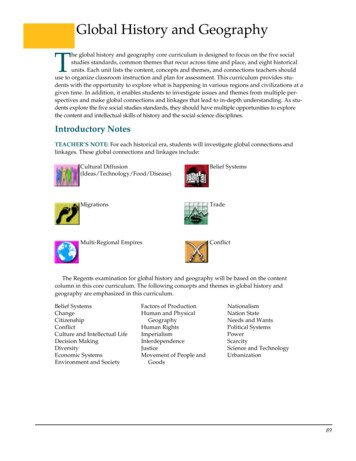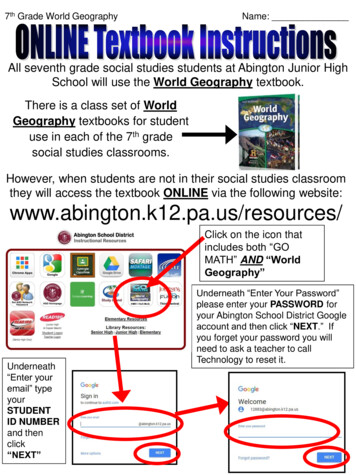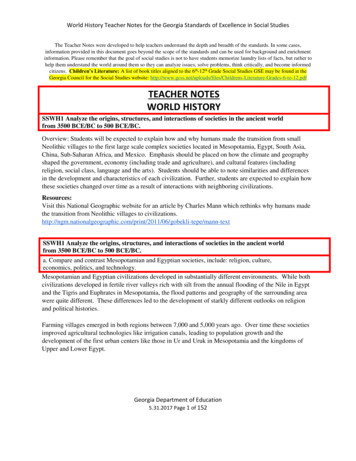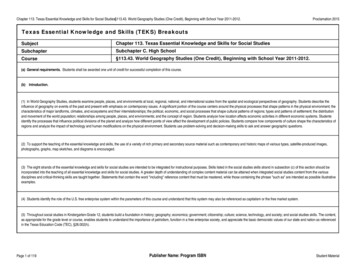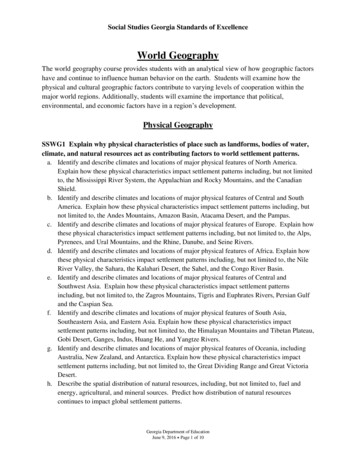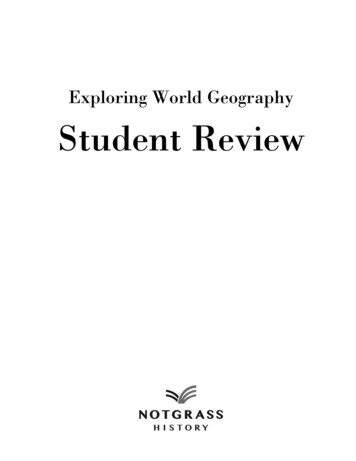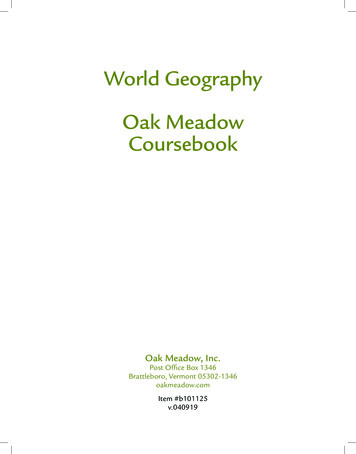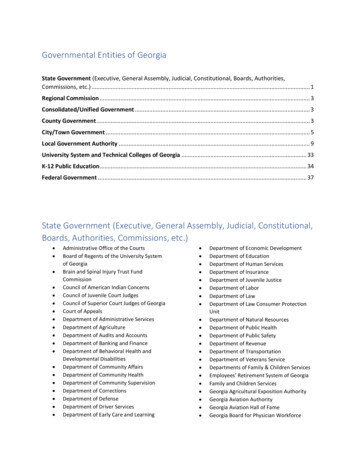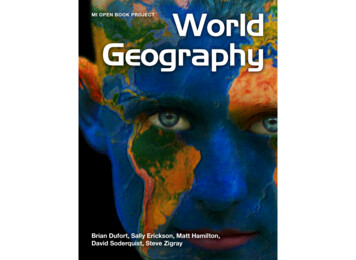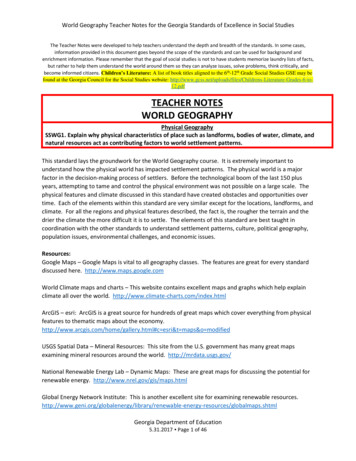
Transcription
World Geography Teacher Notes for the Georgia Standards of Excellence in Social StudiesThe Teacher Notes were developed to help teachers understand the depth and breadth of the standards. In some cases,information provided in this document goes beyond the scope of the standards and can be used for background andenrichment information. Please remember that the goal of social studies is not to have students memorize laundry lists of facts,but rather to help them understand the world around them so they can analyze issues, solve problems, think critically, andbecome informed citizens. Children’s Literature: A list of book titles aligned to the 6th-12th Grade Social Studies GSE may befound at the Georgia Council for the Social Studies website: ture-Grades-6-to12.pdfTEACHER NOTESWORLD GEOGRAPHYPhysical GeographySSWG1. Explain why physical characteristics of place such as landforms, bodies of water, climate, andnatural resources act as contributing factors to world settlement patterns.This standard lays the groundwork for the World Geography course. It is extremely important tounderstand how the physical world has impacted settlement patterns. The physical world is a majorfactor in the decision-making process of settlers. Before the technological boom of the last 150 plusyears, attempting to tame and control the physical environment was not possible on a large scale. Thephysical features and climate discussed in this standard have created obstacles and opportunities overtime. Each of the elements within this standard are very similar except for the locations, landforms, andclimate. For all the regions and physical features described, the fact is, the rougher the terrain and thedrier the climate the more difficult it is to settle. The elements of this standard are best taught incoordination with the other standards to understand settlement patterns, culture, political geography,population issues, environmental challenges, and economic issues.Resources:Google Maps – Google Maps is vital to all geography classes. The features are great for every standarddiscussed here. http://www.maps.google.comWorld Climate maps and charts – This website contains excellent maps and graphs which help explainclimate all over the world. http://www.climate-charts.com/index.htmlArcGIS – esri: ArcGIS is a great source for hundreds of great maps which cover everything from physicalfeatures to thematic maps about the economy.http://www.arcgis.com/home/gallery.html#c esri&t maps&o modifiedUSGS Spatial Data – Mineral Resources: This site from the U.S. government has many great mapsexamining mineral resources around the world. http://mrdata.usgs.gov/National Renewable Energy Lab – Dynamic Maps: These are great maps for discussing the potential forrenewable energy. http://www.nrel.gov/gis/maps.htmlGlobal Energy Network Institute: This is another excellent site for examining renewable a Department of Education5.31.2017 Page 1 of 46
World Geography Teacher Notes for the Georgia Standards of Excellence in Social StudiesThe NREL site has numerous GIS and Analysis tools for looking at renewable energy potential around theworld. http://www.nrel.gov/*See the embedded links and the end of each element for additional resources.SSWG1. Explain why physical characteristics of place such as landforms, bodies of water, climate, andnatural resources act as contributing factors to world settlement patterns.a. Identify and describe climates and locations of major physical features of North America. Explain howthese physical characteristics impact settlement patterns including, but not limited to, the Mississippi RiverSystem, the Appalachian and Rocky Mountains, and the Canadian Shield.Note: students should use the information about the locations below to explain how the climate,location, and physical features impact settlement.Mississippi River System – This vast river system’s water shed takes up almost half of the United States.It has been and continues to be vital for transport of goods, irrigation, drinking water, and electricity.US Army Corps of Engineers: ver-Commission-MRC/Settlement in the watershed was aided and hampered by the river system. Getting people, supplies,livestock, etc. across rivers without a bridge is no small task. The three major rivers of the systeminclude the Ohio, Missouri, and Mississippi each having countless tributaries. The Arkansas and RedRivers also feed the Mississippi. American Indians and European settlers all found the Mississippi Riverwatershed to be life giving. The soil is rich and great for growing crops in the river valleys due tooccasional flooding. Transportation of people and goods was made easier due to the connectedness ofthe river system.Appalachian Mountains – As the first American frontier, the Appalachians were a formidable challengefor settlers attempting to cross and settle to the west. With several peaks at over 6,500 feet, theAppalachians were an intense challenge, although the region had already been settled by AmericanIndians. The Cumberland Gap is a pass through the mountains which offered a much more attainableroute to the west.Georgia Department of Education5.31.2017 Page 2 of 46
World Geography Teacher Notes for the Georgia Standards of Excellence in Social StudiesRocky Mountains – The Rocky Mountain chain begins in New Mexico and extends north throughwestern Canada into Alaska. This massive mountain chain divides the continents watersheds and is aclearly divides most of western North America from the eastern two-thirds.Canadian Shield – Much of the eastern half of Canada is part of the Canadian Shield. This area ischaracterized by the large amounts of igneous and metamorphic rock throughout the landscape.North American Climate – The climate of North America is as diverse as its physical features. Combiningthe physical features and climate of an area, it’s much easier to explain settlement patterns. Theharsher the natural environment, both climate and physical landscape, the more difficult it is to thrive oreven survive.SciJinks-NASA-NOAA: rgia Department of Education5.31.2017 Page 3 of 46
World Geography Teacher Notes for the Georgia Standards of Excellence in Social StudiesSSWG1. Explain why physical characteristics of place such as landforms, bodies of water, climate, andnatural resources act as contributing factors to world settlement patterns.b. Identify and describe climates and locations of major physical features of Central and South America.Explain how these physical characteristics impact settlement patterns including, but not limited to the AndesMountains, Amazon Basin, Atacama Desert, and the Pampas.Note: students should use the information about the locations below to explain how the climate,location, and physical features impact settlement.Andes Mountains – The Andes stretch the entire length of South America from the Southern tip of Chileto Colombia in the north. The highest peak, Aconcogua, reaches almost 23,000 feet. This range isolatesthe west coast of South America from the rest of the continent.B. Trivette: Driving east from the Pacific Coast of Chile towards the Andes.Amazon Basin – The Amazon basin is almost 2.7 million square miles which is just under the size of theentire contiguous 48 states in the United States. It includes all the rivers, streams, and creeks thateventually flow into the Amazon River. It is located in Brazil and in parts of Colombia, Peru, and Bolivia.The amount of biodiversity this basin accounts for is almost unimaginable. Historically settlement wasreserved to small populated communities who lived off the forest and rivers. With the advent ofchainsaws and bulldozers, much of the Amazon Basin has been impacted by modern humandevelopment.Atacama Desert – The Atacama is the driest desert that is not polar on earth. Rain may not fall foryears. It is a plateau that sits to the west of the Andes and east of the Pacific. It is located primarily inChile but also is inside parts of Bolivia, Peru, and Argentina.Pampas – The Pampas is primarily located in Argentina but is partly located in Uruguay and Brazil. It is avast plain dominated by grasslands. This region is vast covering close to 300,000 square miles. It isseparated into a more arid region to the west and humid region with more precipitation in the east.Georgia Department of Education5.31.2017 Page 4 of 46
World Geography Teacher Notes for the Georgia Standards of Excellence in Social StudiesSSWG1. Explain why physical characteristics of place such as landforms, bodies of water, climate, andnatural resources act as contributing factors to world settlement patterns.c. Identify and describe climates and locations of major physical features of Europe. Explain how thesephysical characteristics impact settlement patterns including, but not limited to the Alps, Pyrenees, and UralMountains, and the Rhine, Danube, and Seine Rivers.Note: students should use the information about the locations below to explain how the climate,location, and physical features impact settlement.Alps – The Alps mountain range runs from Monaco in the west to Slovenia in the east. It can be found inparts of France, Germany, Switzerland, Italy, and Austria. Mont Blanc on the border between Italy andFrance is the tallest peak in the mountain range at just under 16,000 feet.Pyrenees – The Pyrenees range forms a natural border between France and Spain. The micro-state ofAndorra sits within the Pyrenees between France and Spain. At just over 11,000 feet the mountaincalled Aneto is the tallest in the chain.Ural – The Ural mountain range runs north and south from northern Kazakhstan, through the heart ofRussia, to the Arctic Ocean. The Urals effectively divide Europe from Asia.Rhine – The Rhine River’s source is in the Alps in Switzerland. The river runs north becoming the borderbetween Switzerland and Liechtenstein, Switzerland and Germany, southwestern Germany and France,before being exclusively in Germany. The river becomes a delta within the Netherlands and finallydumps into the North Sea.Danube – The Danube River has its origin in southern Germany. It flows primarily east through southernGermany, Austria, becomes the border between Slovakia and Hungary, through Hungary, becomes theborder of Croatia and Serbia, through Serbia, becomes the border between Bulgaria and Romania, formsthe border between Ukraine and Romania, before ending in the Black Sea.Seine – the River Seine begins just east of Paris, France from the confluence of two other rivers. TheSeine meanders northwestward though northern France before ending in the English Channel.Georgia Department of Education5.31.2017 Page 5 of 46
World Geography Teacher Notes for the Georgia Standards of Excellence in Social StudiesSheftel Social Studies: rope.htmlSSWG1. Explain why physical characteristics of place such as landforms, bodies of water, climate, andnatural resources act as contributing factors to world settlement patterns.d. Identify and describe climates and locations of major physical features of Africa. Explain how thesephysical characteristics impact settlement patterns including, but not limited to the Nile River Valley, theSahara, the Kalahari Desert, the Sahel, and the Congo River Basin.Note: students should use the information about the locations below to explain how the climate,location, and physical features impact settlement.Nile River Valley – The Nile River begins at the confluence of the White and Blue Nile Rivers. The Riverruns north for over 4,000 miles through Sudan and Egypt. It creates the Nile River Delta in northernEgypt. The water from the Nile eventually ends up in the Mediterranean Sea. This abundance of freshwater flowing through the Saharan Desert makes abundant life possible.Georgia Department of Education5.31.2017 Page 6 of 46
World Geography Teacher Notes for the Georgia Standards of Excellence in Social StudiesUSGS Water Science School: htmlSahara Desert – The Sahara Desert dominates Northern Africa taking up an area of over 3.6 millionsquare miles. This desert is similar in size to all of China. It is located in the following countries: Egypt,Sudan, Libya, Chad, Tunisia, Niger, Mali, Algeria, Mauritania, Morocco, and Western Sahara. It isdominated by vast areas of dunes. The sand from the Sahara can sometimes end up in North and SouthAmerica if weather patterns allow.Kalahari Desert – This desert is located in Botswana, South Africa, and Namibia. The Kalahari is differentthan the Sahara because it is not as dry and supports a savannah ecosystem.Congo River Basin – The Congo Basin is second in size, only behind the Amazon Basin. The Congo drainsfrom the East African Rift to the Atlantic Ocean. The following link shows you a great map of the sizeand drainage area of the Congo River Basin: http://arcg.is/2ckYlEQ The Congo Basin includes all or partsof ten countries in Sub-Saharan Africa including the Democratic Republic of the Congo, Congo,Cameroon, Tanzania, and Zambia. The Congo River itself is second to the Nile in length of all Africanrivers.SSWG1. Explain why physical characteristics of place such as landforms, bodies of water, climate, andnatural resources act as contributing factors to world settlement patterns.e. Identify and describe climates and locations of major physical features of Central and Southwest Asia.Explain how these physical characteristics impact settlement patterns including, but not limited to the ZagrosMountains, Tigris and Euphrates Rivers, Persian Gulf and the Caspian Sea.Note: students should use the information about the locations below to explain how the climate,location, and physical features impact settlement.Georgia Department of Education5.31.2017 Page 7 of 46
World Geography Teacher Notes for the Georgia Standards of Excellence in Social StudiesZagros Mountains – The Zagros Mountains run through Iran, Iraq, and Turkey. This is the largestmountain range in the region at just under 1000 miles long. The highest peaks are over 14,000 feethigh.Tigris and Euphrates Rivers – Known historically as the Fertile Crescent, these two waterways begin inTurkey and go through Syria and Iraq. They combine is southeastern Iraq to create the Shatt al-Arabbefore flowing into the Persian Gulf.Persian Gulf – The Persian Gulf is connected to the Gulf of Oman and Arabian Sea by the Strait ofHormuz. Iran, Iraq, Kuwait, Bahrain, Qatar, Saudi Arabia, and the United Arab Emirates all have shoreson the Gulf. It is over 96,000 square miles, is 615 miles long, and is between 35 and 200 miles wide.Caspian Sea – Classified as the largest lake in the world, it is inside a basin without any outlet. TheCaspian Sea sits between Europe and Asia and is bordered by Russia, Iran, Kazakhstan, Azerbaijan, andTurkmenistan.SSWG1. Explain why physical characteristics of place such as landforms, bodies of water, climate, andnatural resources act as contributing factors to world settlement patterns.f. Identify and describe climates and locations of major physical features of South Asia, Southeastern Asia,and Eastern Asia. Explain how these physical characteristics impact settlement patterns including, but notlimited to the Himalayan Mountains and Tibetan Plateau, Gobi Desert, Ganges, Indus, Huang He, and YangtzeRivers.Note: students should use the information about the locations below to explain how the climate,location, and physical features impact settlement.Himalayan Mountains and Tibetan Plateau – Containing the highest and most impenetrable mountainsin the world, the Himalayas provide a border between the Indian sub-continent and Asia Proper. TheHimalayas contain dozens of peaks over 20,000 feet with Mount Everest, at just over 29,000 feet, beingthe tallest mountain on earth. The Tibetan Plateau sits north of the Himalayas and extends well intowestern China. The plateau has numerous glaciers and is a reliable source of water in the region.Gobi Desert – Located in the north of China and southern Mongolia, the Gobi is a high elevation desertwith an area of around 500,000 square miles.Ganges River – The Gages begins in the Himalayas and flows southeast through northeast India beforecrossing into Bangladesh where it becomes a delta as it empties into the Bay of Bengal. The Ganges hasa length of just over 1,500 miles.Indus River – The Indus River has a length of around 2,000 miles. It begins in the Tibetan Plateau inChina and flows west into northern India before turning south-southwest into Pakistan. The Indus flowsthe length of Pakistan before draining into the Arabian Sea.Huang He River – Also known as the Yellow River, it begins in the Bayan Har Mountains in central Chinaand flows primarily east into the Yellow Sea of China’s east coast.Georgia Department of Education5.31.2017 Page 8 of 46
World Geography Teacher Notes for the Georgia Standards of Excellence in Social StudiesYangtze River – The Yangtze begins in the Kunlun Mountains, southwest of the Huang He’s source, andflows almost 4,000 miles east into the East China Sea. It is the third longest river in the world behind theAmazon and the Nile.SSWG1. Explain why physical characteristics of place such as landforms, bodies of water, climate, andnatural resources act as contributing factors to world settlement patterns.g. Identify and describe climates and locations of major physical features of Oceania, including Australia,New Zealand, and Antarctica. Explain how these physical characteristics impact settlement patternsincluding, but not limited to the Great Dividing Range and Great Victoria Desert.Note: students should use the information about the locations below to explain how the climate,location, and physical features impact settlement.Great Dividing Range – Spanning for over 2,000 miles, the Great Dividing Range extends along thewhole east coast of Australia. It happened to be the third longest mountain range in the world. Itspeaks are not as striking as other world mountain ranges, with maximum heights to just over 7,000 feet.This mountain range effectively separates the populated east coast of Australia from the Outback, whichcovers the vast majority of the country.Great Victorian Desert – At about 135,000 square miles in size, the Great Victorian Desert is the largestin Australia. It is a barren area taking up much of south central and southwest Australia. The area isvery sparsely populated.Great Barrier Reef – This is the largest reef in the world at over 130,000 square miles in size. It spans1,400 miles from north to south off Australia’s east coast. The diversity and abundance is much like therainforests of the Congo River Basin and Amazon Basin except under the ocean.SSWG1. Explain why physical characteristics of place such as landforms, bodies of water, climate, andnatural resources act as contributing factors to world settlement patterns.h. Describe the spatial distribution of natural resources, including, but not limited to fuel and energy,agricultural, and mineral sources. Predict how distribution of natural resources continues to impact globalsettlement patterns.The spatial distribution of natural resources is a massive driver in settlement patterns. The world’sspatial distribution of natural resources are very specific to region. See the map below for an example.Georgia Department of Education5.31.2017 Page 9 of 46
World Geography Teacher Notes for the Georgia Standards of Excellence in Social StudiesU.S. Energy Information Administration: /The distribution, abundance, and accessibility of natural resources and the impact that has on the worldmay be the major issue in the future as population is expected to possibly double in the next 50 years.As more countries develop, they will have a greater need and want for energy, which will drain nonrenewable fossil fuels and add exponentially to carbon emissions. With changing climates, areas longsuitable for one crop may no longer be. Mineral deposits could become more and more scarce themore the people of the world demand. If energy resources, mineral deposits, and agriculture output allare stressed and become scarce, the remaining wilderness left on the earth will be threatened bynatural resource exploration. Global settlement will be determined by how natural resources aremanaged. The key will be renewable energy and water conservation. The following map is from theNational Renewable Energy Lab (NREL) showing the solar potential for China.NREL Solar Potential: http://www.nrel.gov/gis/images/international solar/china solar pv-01.jpgGeorgia Department of Education5.31.2017 Page 10 of 46
World Geography Teacher Notes for the Georgia Standards of Excellence in Social StudiesCultural GeographySSWG2 Evaluate how the physical and human characteristics of places and regions are connected tohuman identities and cultures.The cultural geography standard examines and looks for an understanding as to why cultures developedthe way they did. One can have a much broader understanding of the world with an understanding ofcultural geography. This standard includes religion, language, ethnicity, race, and gender among othertopics. Comparing, contrasting, and analyzing different cultures helps students understand people andplaces foreign to them.Resources:BBC – Religions of the World: This site gives a good overview of numerous religions found all over theworld. http://www.bbc.co.uk/religion/religions/Harvard – Ethnicities of the World Map: This particular interactive map has incredible amounts ofinformation. The mother site contains other great resources for all standards in world geography.http://worldmap.harvard.edu/maps/1894CIA World Fact book – Ethnicities by country: This part of the CIA World Fact book is a great sourcewhen examining groups within particular countries. factbook/fields/2075.htmlSSWG2 Evaluate how the physical and human characteristics of places and regions are connected tohuman identities and cultures.a. Examine how ethnic compositions of various groups has led to diversified cultural landscapes, Including,but not limited to architecture, traditions, food, art, and music.Ethnicity and Cultural Landscape - The term ethnicity is subjective and is based on each individualgroup. Ethnicity is not the same as race. It has nothing to do with physical characteristics. Ethnicity isbased on cultural traits and customs such as language, religion, dress, etc. The term cultural Landscaperefers to how humans have physically impacted the natural layout of the land by their actions. Thisincludes buildings, road structures, agriculture, energy production, etc.Architecture and Cities - Ethnic groups have increasingly commingled, especially in the past fewcenturies with the advent of more and efficient means of transportation and more recently withcommunication technology. The cultural landscape around the world shows distinct signs of thisespecially through the exploration of cities. Visiting and experiencing any cosmopolitan city in the worldtoday allows one to see just how much influence different ethnicities have had. The use of Google Mapsis a great tool to visually show the students the cultural landscapes. The best example city in the UnitedStates to discuss is New York City. It is home to approximately 8.5 million people just within the citylimits comprising dozens of ethnicities. Each ethnicity has a unique cultural flavor which can be seenthrough architecture such as houses of worship. Within just a few blocks one can come across aCatholic cathedral, a mosque, and a Hindu temple. Other great examples of diverse religiousarchitecture can be found in Seville, Spain and Istanbul, Turkey. Both of these are examples of how theGeorgia Department of Education5.31.2017 Page 11 of 46
World Geography Teacher Notes for the Georgia Standards of Excellence in Social Studiesbattle of cultures and conquest led to the present architectural hearts of the cities. In both places onecan find both Christian and Muslim architectural traits within the same area and even inside the samestructure. For a great spatial map of ethnic diversity in NYC see: New York Times; “Then as Now — NewYork’s Shifting Ethnic Mosaic” by Ford Fessenden and Sam RobertsTraditions, Art, Music and Food - Within diverse cultural landscapes different cultural traits and customswill be apparent. One ethnicity’s customs such as religious occasions, holidays, festivals, andcelebrations will occur simultaneously with others. These will include traits such as music, dance, andfood for the occasions. By referencing the above map, one can draw inferences as to how and whenthese interactions may occur. Food is one example where cultural diffusion has had an extraordinaryimpact. Today, our globalized world allows us to eat foods from all over the world at any time wechoose. It may not be completely authentic, but it is within the realm of the cultural norm. Works of artfrom cultures around the world can be found in museums in most large cities around the world. Thereare permanent collections and art sharing programs which are another means of sharing diversecultures. Within our diverse cultural landscape, globalization has led to the rapid diffusion of Westernpop music all over the world. Walking through a department store or riding in a cab in Europe or Asia, itis not uncommon to hear American top fifty music. Styles of music such as rap, have also spread andbecome part of pop culture even in very conservative places such as Iran.SSWG2 Evaluate how the physical and human characteristics of places and regions are connected tohuman identities and cultures.b. Examine how language can be central to identity and a unifying or a divisive force (e.g., Bantu, FrenchCanadians (Quebecois), and Basques)One of the most unifying characteristics of a particular culture is language. Being able to verballycommunicate is vital for human societies. Language can also be a point of contention if members of asociety will not assimilate and adopt the language of the majority. Bantu is a family of languages spokenprimarily in Sub-Saharan Africa. Although there is no certain exact number of Bantu languages,estimates put the number into the hundreds. Millions of people in Africa speak Bantu languages. Themost common is Swahili. Swahili is spoken as a second language in many areas of East Africa whichallows many form different ethnicities with different primary languages to communicate easily.French-Canadians have used their version of French as a rallying cry for independence or at least semiautonomy of the province of Quebec. A law passed in the 1970’s proclaimed French the officiallanguage of Quebec. The law allows and promotes French to be the language for everything official inQuebec. The easiest way to observe this is by driving in Quebec. The street and highway signs alongwith menus are primarily in French with English secondary.Georgia Department of Education5.31.2017 Page 12 of 46
World Geography Teacher Notes for the Georgia Standards of Excellence in Social StudiesKids Britannica: reet-signs-in-Quebec-are-in-French-and-English Zomato: gatineau/menuQuebec held a referendum on independence from Canada in 1995. It was defeated by one percent afterthe votes were counted. The culture of Quebec is inherently different than its neighboring provincesdue to its language.The Basque region with speakers of the language is located in northern Spain and extreme southwestFrance on the Bay of Biscay. This region contains one of the most unique languages in the world. TheBasque language is not related to any other languages anywhere on earth. This alone has led the peoplewho speak it to feel culturally unique and united. There is a movement, as there has long been, forindependence from Spain. This has led to conflict with the federal government in Madrid, who againstany secession ideas.Another region in Spain with a similar issue as the Basques is Catalonia. It is located in the Northeast ofSpain with its capital in Barcelona. The residents here generally speak Catalan before they speakSpanish. There is a fierce spirit of independence in Catalonia and a very large movement for areferendum to leave Spain and become independent. The language unifies the people of Catalonia, butso does their wealth. It is the richest region in Spain and many there don’t want to pay the bills for therest of the country. The image below shows an example of a pro-independence Catalan street protest inBarcelona from 2012.The Sunday Times: http://www.thesundaytimes.co.uk/sto/news/world news/Europe/article1131842.eceGeorgia Department of Education5.31.2017 Page 13 of 46
World Geography Teacher Notes for the Georgia Standards of Excellence in Social StudiesSSWG2 Evaluate how the physical and human characteristics of places and regions are connected tohuman identities and cultures.c. Examine the effects of universalizing and ethnic religions on local populations, including, but not limited toChristianity, Judaism, Islam, Hinduism and Buddhism.Universalizing religions are religions always seeking new converts and make up the largest religions inthe world. These include Christianity, Islam, and Buddhism. Ethnic religions do not seek out morefollowers, but are generally more locally contained to a common group of people. Followers are borninto the faith. Judaism and Hinduism are examples of ethnic religions. Ethnic religions are generallyolder religion
World Geography Teacher Notes for the Georgia Standards of Excellence in Social Studies Georgia Department of Education 5.31.2017 Page 5 of 46 SSWG1. Explain why physical characteristics of place such as landforms, bodies of water, climate, and natural resources act as contributi
